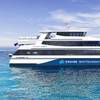Neary four million tons of coal passed in and out of Scotland's Hunterston Terminal in 1997, drawn in large part by a reputation for fast turnaround that has made this one of the biggest seaport bulk transhipment facilities in Western Europe. But, building that reputation wasn't easy.
Moving coal at 2,000 to 3,000 tons per hour (tph), through some five miles of conveyors linked by multiple transfer points, the terminal had long been plagued by spillage problems that laid a costly burden on the maintenance staff and threatened penalty charges from delays in ship loading/unloading. The search for a more reliable way to keep the coal on the belts finally ended when maintenance management found a new system for keeping skirt rubber in place at the transfers and more easily adjusted.
The problem goes back to the late 1970s, when the terminal was built for British Steel as a receiving port for iron ore and coal, and was still unsolved when the privatizing of British Steel idled the property in 1991. It surfaced again when Clydeport Operations Ltd. bought the facility in 1993 and refurbished it as one of four deepwater terminals making up the 450 square-mile Clydeport complex, now the major import/export gateway to central Scotland.
Strategically positioned where the River Clyde begins curving from its Atlantic Ocean estuary toward Glasgow - covering 494 acres of land, about 30 percent of it reclaimed from the sea - Hunterston is twice the size of the other Clydeport terminals. Its major function is to receive steam coal from as far away as Australia and Indonesia, and send it back out by ship, rail and truck, primarily to the electrical generating plants of Northern Ireland Electricity, Scottish Power and England's Eastern Energy.
The terminal also handles a relatively small volume of aggregate plus shipments for two contract firms headquartered on site: one imports U.S. petroleum coke for cement kiln fuel, and the other receives run-of-mine coal for processing and resale to users in Norway, Spain, Ireland and England.
With an enclosed conveyor causeway and jetty extending more than a mile offshore - the largest of its kind in Britain - Hunterston can receive bulk carriers of up to 350,000 dwt at the jetty's outer berth. The terminal can dispatch vessels up to 70,000 dwt (150,000 dwt with dredging) from its inner shiploading berth. Currently, inbound/outbound traffic is running at the rate of approximately 300 ships per year.
Incoming coal is taken off ship by two giant grab unloaders, each biting 25.5 tons per grab to maintain a 1,500 tph flow, and brought ashore on a series of four conveyor belts totalling 6,509 ft. in length.
The final belt in that series incorporates a travelling tripper that transfers incoming coal onto any of three stockyard belts, all extending 3,051 ft. to the same side at right angles, spaced 246 ft. apart, reaching out across the terminal's 123.5 acre stockyard.
A mobile stacker/reclaimer roams the length of each stockyard belt. Equipped with reversible boom conveyors and bucket wheels at the end of their stacker booms, these machines can either create stockpiles at 3,000 tph or consume them at 2,000 tph. Retrieved coal goes back onto the stockyard belt but continues to the far end of the yard where telescoping heads let them transfer onto either of two parallel reclaim conveyors.
Each of the two reclaim conveyors ends in a traveling chute allowing transfer of cargo either onto an outbound four-conveyor series traveling 9,774 ft. back to the jetty for shiploading, or onto an alternate five-conveyor series moving in the opposite direction, traveling 3,517 ft. to the terminal's rail wagon (railcar) loading station. This arrangement permits simultaneous output for both ship and rail loading.
The outbound shiploading conveyor line also carries a traveling tripper that can return coal to any of the three stockyard belts, enabling stockpiles to be rotated to different locations within the yard.
Belts in the inbound series and stockyard conveyors are 63 in. wide, and those in the outbound series and rail loading conveyors are 55 in. wide; all run at a fixed speed of 9.8 ft./sec. In total, Hunterston's system comprises 20 individual conveyors, ranging in center-to-center length from 4,009ft. on the longest causeway belt to 98.4 ft. on the shortest weigh conveyor.
According to John Moore, maintenance manager, whose tenure here goes back to the British Steel days, spillage at the transfers was routine from the early days of operation. "At its worst, either the incoming or outbound runs could have spillage at each of six transfer points that could drop a total of 1,500 tons on a shipload," he recalls.
"In the days when British Steel also owned the cargo and the ships it came in, this wasn't a major problem. We'd simply pick up the spilled coal or iron ore and put it back on the stockpiles. They were bringing in maybe four vessels a month, so there was plenty of time to do that."
Privatization under Clydeport Operations changed the picture dramatically, he continues. "When you're handling shipments for paying customers, they want to be sure of the exact amounts bought or sold, and seeing spillage lying around raises doubts they might not be getting what they paid for. If the spillage really is theirs, it can change the weighed volume by hundreds of tons and make it necessary to adjust the billing. Worse, it can delay the loading a ship, perhaps to the point of incurring a penalty."
Hunterston guarantees each vessel will be unloaded or loaded within a certain time period, he explains. Delaying completion beyond the guaranteed period is penalized at the rate of $25,000 per day.
In order to avoid penalties, spillage usually was left where it fell until the shipload was completed and the bill was adjusted on the basis of vessel displacement, then trucked back to storage later. In one case Moore recalls, the spillage loss was so bad temporary adjustments and repairs couldn't stop it, and an extra shift had to be added to meet the contract deadline. "At that time, we normally operated with two 8-hour shifts, but putting in a full 24 hours on that load's final day was cheaper than paying the penalty...even after spending an extra $1,600 in hired labor to clean up the mess."
As the terminal grew busier, three-shift, round-the-clock operation has become commonplace, he notes, so the extra eight-hour cushion against such emergencies no longer exists.
"For all these reasons, finding a better way to control spillage at the transfers soon became a very high priority," he says.
Moore explains the original spillage control skirts, installed when the plant was built, caused trouble for several reasons. First, their holding brackets were installed too high above the belt, which left the skirt rubber extended too far with too much flexibility. This allowed the load or a mis-tracking belt to push the skirt rubber off over the belt edge, which not only invited spillage, but also tended to hold the belt off track.
That system's holding brackets had to be mounted high in order to allow enough room to operate their clamping mechanism, essentially an eccentric cam that is turned by moving a lever handle then locked in position by inserting a steel pin through a hole in the cam.
"We found this a complicated system and hard to work with," Moore says. "The pins often became rusted and had to be knocked out so the cam could be turned, and usually we had to slide a length of tubing over the handle to get enough leverage to turn it. In tight quarters, there wasn't always enough room to pull the handle around."
Perhaps the worst problem was the clamping action wasn't very positive, he contends. "Sometimes the rubber would be pulled right out of its bracket by the belt sliding under it, and spillage became a cascade.
"Of course, when British Steel opened the terminal," he adds, "they laid in a supply of spares for these skirts, so we were stuck with them for about eight years."
After this supply was exhausted, Moore tried a system that used thick blocks of skirt rubber specially shaped to fit tightly into holding brackets. "There was no clamping mechanism," he recalls. "The blocks were just hammered down into contact with the belt and their tight fit was supposed to hold them there."
Two problems showed up quickly, he reports. First, the rubber was very hard, and if driven down too far, scored the belts. Second, the tight fit wasn't tight enough.
"We learned coal could wedge its way beneath a block and lift it, then that block would stay in the raised position like an open sluice gate. We were constantly hammering them back down. It got so we had to anticipate which conveyor lines would be needed for the next ship and concentrate on adjusting each skirt along that path, and sometimes that would take three or four people working all day."
"With only a few maintenance people on duty each shift, we never had enough people to get the rest of our work done. We just couldn't afford to have them spending so much time on skirt adjustment."
Trouble Spots Test New Design
In December 1996, Hunterston reopened its rail loading facility, which had been idle since the closing of the steel mill it was built to supply. Two bunkers - originally intended to allow separate, simultaneous loading of iron ore and coal - rise 112 ft. over sidings linked to the national rail network. Designed for unit-train service, each bunker is long enough to simultaneously load three 100-ton rail wagons (railcars). An enclosed 1,444 ft. conveyor, inclined at approximately 30 degrees, lifts the coal to the top of one bunker, then feeds the other bunker by way of an aerial bridge conveyor that spans the 32.8 ft. gap between the structures, again at an approximately 30 degree incline.
The 90 degree transfer where the bridge conveyor meets the belt feeding the second bunker was a trouble spot from the first day British Steel started using it, due to its short chute, Moore says. Workers were stationed there to shovel up the spillage and wheelbarrow it to the bunker.
"When the time came to reactivate this line, we knew the old spillage problems would be coming back, so this looked like a good opportunity to try a new type of skirt clamp that promised to be a lot more reliable and easily adjusted."
Known as Flex-Lok, the new system is produced by Flexco, a worldwide supplier of belt conveyor maintenance products based in the U.S. Developed only a few years ago in Australia by Belle Banne Flexco Pty Ltd., a Flexco subsidiary, Flex-Lok was recently introduced in the UK through the Flexco subsidiary in Lancashire, England.
First of its kind in the conveyor industry, the Flex-Lok system features specially designed clamp plates that tighten or loosen by the sliding action of a wedge-shaped cotter, when tapped with a hammer. Clamp plates mount on a central steel runner, which is welded to the outside of the conveyor's skirt plate. Each clamp plate is attached by a flanged steel pin keyed into the runner. The cotter is captive in the end of the pin to prevent falling off and becoming lost. By turning the pin, the cotter can be rotated to whichever angle best accommodates the hammer stroke to make skirt adjustment as convenient as possible in confined spaces. No other tools are needed.
After runner and pin assemblies are installed, clamp plates are mounted loosely on their pins, and a 6 ft. restraining bar is set in place across four or more clamp plates, held by a socket formed into the lower end of each clamp plate. The skirt rubber is set in place between the bar and the conveyor's skirt plate, and allowed to rest naturally on the conveyor belt top cover. Hammer taps on the cotters then complete the installation by tightening the clamps, gripping the rubber firmly against the skirt plate along the entire length of the restraining bar.
Easy Adjustment, Standard Material
Subsequent adjustments are made by simply tapping all cotter keys in reverse to loosen the clamps, letting the entire length of rubber settle to rest again on the belt, then tapping all cotters forward to retighten.
For replacement economy, Flex-Lok Skirt Clamps use virtually any skirt material from .31 to .63 in. thick, and four to eight in. wide.
"This is a big benefit," Moore notes; "with our previous system, we had to use their specially shaped blocks, which were more expensive than standard skirt rubber. Now we use standard .75 in. thick material.
"The Flexco system has been in use at the rail bunkers since February, and its maintenance time has been negligible," he says. "The engineering is right; it's easy to fit, robust, and anybody who can swing a hammer can adjust it. Gravity sets the skirt contact so no judgement is necessary."
Seeing spillage ended at the rail loading transfer, Moore quickly tested Flex-Lok on two other transfers where spillage has been a problem...the reversible boom conveyor on one of the yard stacker/reclaimers, and one of the dual transfers where the traveling trippers from either incoming or outgoing conveyors dump onto a stockyard belt.
"We used to have horrendous problems at the dual transfers," he says. "The skirts here are 55.8 ft. long to span both transfer points, and used to need a lot of attention. With our earlier system, that total length was made up of separate 6.5 ft. sections of skirt rubber, and the breaks between sections allowed a lot of leakage.
"With Flex-Lok, we can cut standard skirt rubber to full length and put it in as a single piece."
Shortly after fitting the dual transfer with Flex-Lok, that line emptied a 141,000 ton vessel, running through the transfer for 35 hours with 100 percent availability and no spillage, he reports.
"With our previous skirts, we probably would have had 40 to 50 tons on the ground, which would have taken a week to clean up with a bobcat.
"These results on our three toughest trouble spots have made it clear we've found the solution to our spillage problems," he says. "We'll soon be refitting the entire site with Flex-Lok"
Sponsored Content
Protect Your Crew. Exceed Weld Standards.

MSC Sets a New Standard for Time Off in 2025, Plus Earn a $44,345 Bonus as an Able Seaman!

Subscribe for
Maritime Reporter E-News
Maritime Reporter E-News is the maritime industry's largest circulation and most authoritative ENews Service, delivered to your Email five times per week










